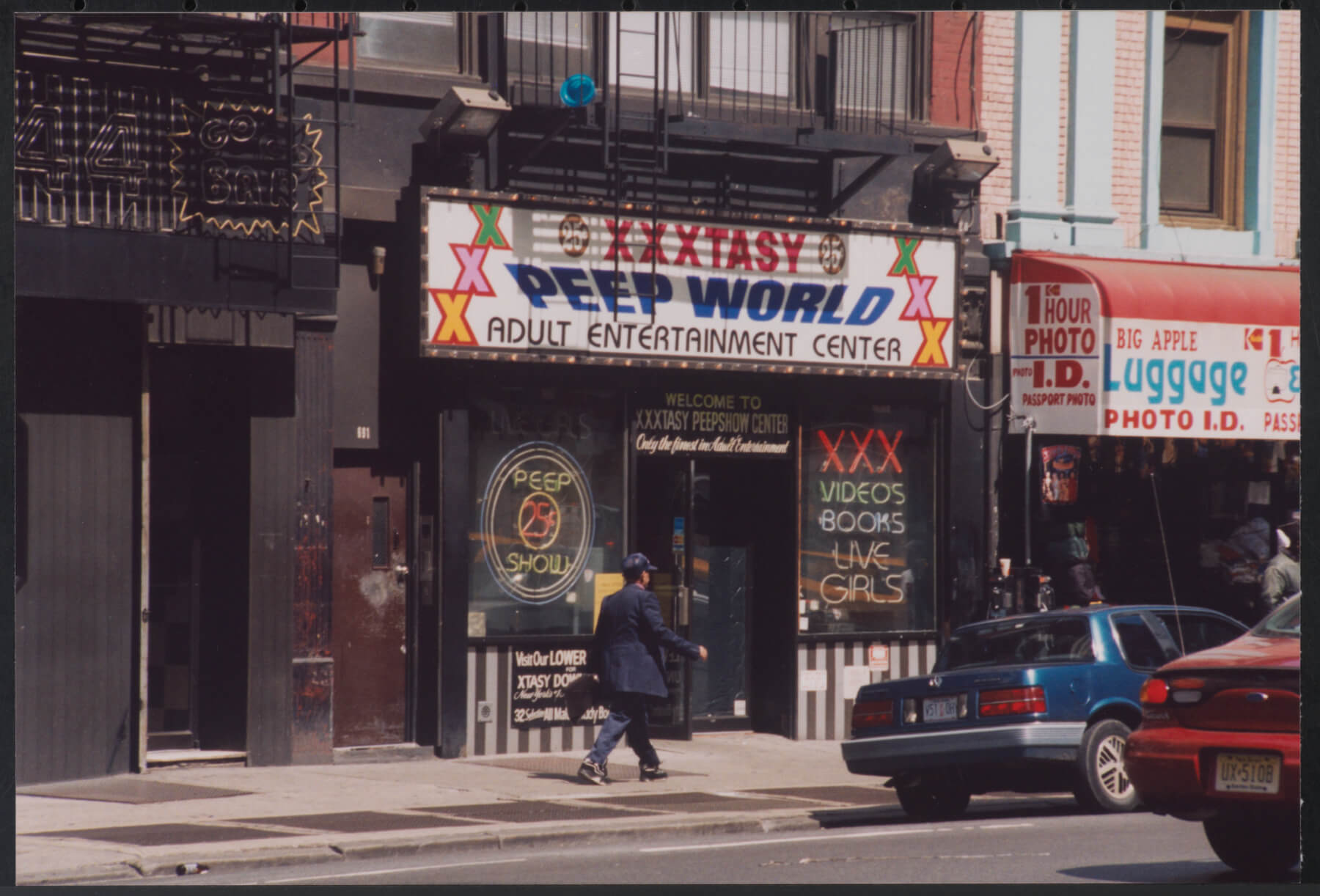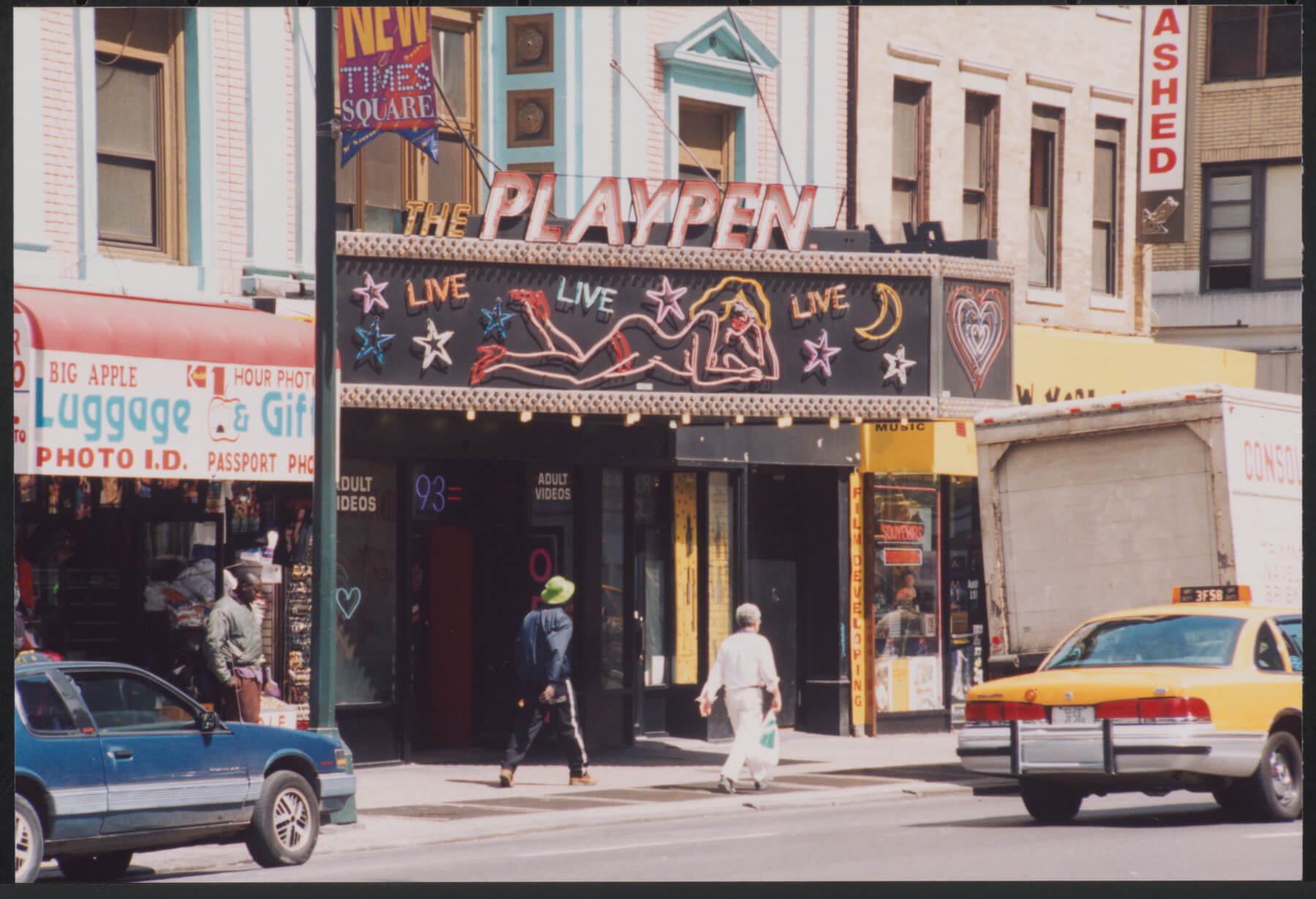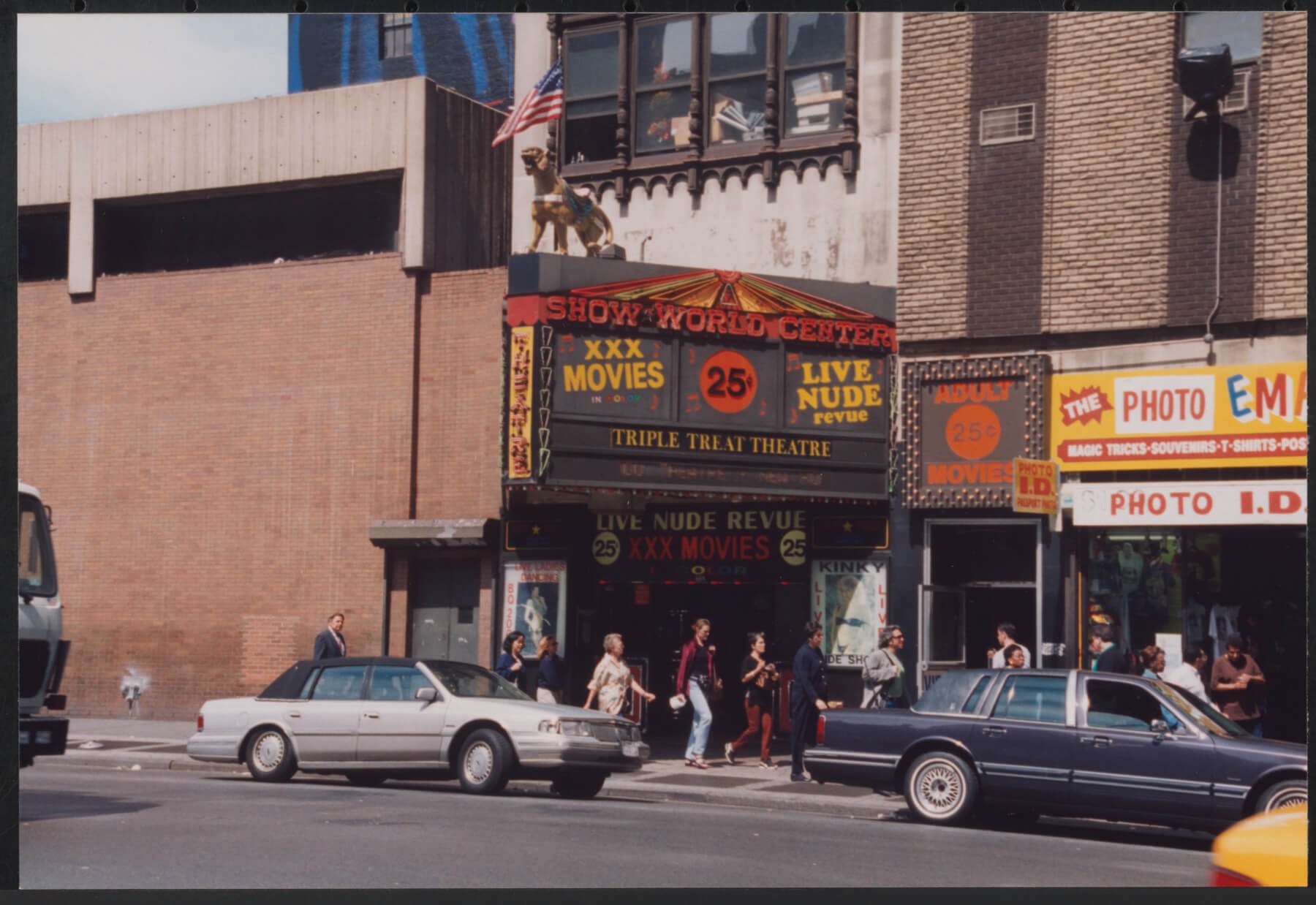Rudy Giuliani wanted to clean up Times Square. Some thought this was because it needed cleaning, others because Disney said, “If you clean it, we will come.” Whatever his motive, when Giuliani moved into Gracie Mansion in 1994, he wasted no time targeting for eviction the neon-spangled sex shops, peep shows, and porno palaces of Manhattan’s red-light district. He focused with particular zeal on West Forty-Second Street, from Broadway to Eighth Avenue, the sleaziest block of the Deuce, home to the decaying New Amsterdam Theatre that Disney was eyeing as a possible outpost for its family-friendly anesthesia.
Giuliani was not the first crusader to push a broom down Forty-Second Street. Campaigns to purge the area of vice go back to the late nineteenth century, before it was even known as Times Square, though plans to turn it into a sanitized “urban theme park” only took shape under the mayoralty of Ed Koch in the 1980s, in response to increasing prostitution and drug use. “We want to bring fantasy back to Times Square,” the chair of the city’s planning commission said in 1986, “and replace much of the grim reality that currently exists.” That meant using eminent domain to seize and condemn unsavory properties along Forty-Second Street as part of a “revitalization” effort that would include the construction of a glut of skyscrapers. Unfortunately for city planners, the sex didn’t go away quietly. The adult bookstores and strip clubs simply migrated—mainly further uptown or south to neighborhoods like Chelsea and Greenwich Village. And they took their flashy signage with them, which the areas’ residents didn’t like at all.
Frustrated that condemnation didn’t work, the newly elected Giuliani administration pursued an amendment to the city’s Zoning Resolution that would strictly regulate where these businesses could be located—the most aggressive effort in the city’s history to restrict the use of private property for commercial sex. Before voting on the amendment, the city council held hearings at which a wide range of voices, both for and against, were heard. The Times Square Business Improvement District and real estate interests were—of course—in favor. Manhattan Borough President Ruth Messinger proposed other options, such as tightening enforcement of existing signage laws pertaining to size and illumination. Perhaps if adult businesses ditched their garish storefront displays—“Live! Girls! Girls! Girls!”—then the community would not take notice.
But Messinger’s proposal was rejected. In 1995, the city council voted overwhelmingly to amend the Zoning Resolution to include regulations for “adult establishments”—effectively debarring businesses that were entirely legal, however distasteful some felt them to be. It was then that I became closely involved in the issue. I worked at the Mayor’s Office of Midtown Enforcement, the city agency chosen to spearhead the new regulations’ enforcement.

Rod of Correction
Most American cities have some form of regulation dividing them into sections or zones where residential, commercial, and manufacturing uses are permitted; specific rules for development and use apply in each mapped district. Zoning is the mechanism that keeps different uses separated. For example, it prevents a slaughterhouse from opening next to a single-family home.
In the 1970s, over a hundred adult businesses could be found in Times Square. Today, only a handful remain.
According to the Constitution’s First Amendment, the goods and services offered by adult establishments are protected speech, which meant that Giuliani’s law and order administration couldn’t outlaw them outright. Zoning, however, allowed the city to severely restrict where they might be offered to the public. Under the new law, adult establishments were prohibited from being within five hundred feet of schools, houses of worship, residential districts, and each other. The hope was to break up the concentration of adult theaters, bars, and video stores in the Times Square/Forty-Second Street area and send them to the city’s fringes—far away from tourists.
But as soon as the new law was passed, its constitutionality was challenged by a group of adult business owners and their First Amendment attorneys—and enforcement was stayed for just under three years. While our office waited for the courts to rule on the legislation’s constitutionality, we were tasked with inventorying the establishments and determining if they fit the zoning requirements. Over two days, driven around Manhattan in an unmarked police car, I photographed forty-five storefronts to supplement our files. Our other duty was to determine if a business would be legally considered an adult establishment, which was defined in the new law as one regularly featuring goods and services that included the “depiction or display of specified sexual activities or specified anatomical areas.” These activities and areas were spelled out in the zoning regulation.
During the stay period, New York City’s adult industry prepared for the worst and went to great lengths to comply. One strip club owner called our office about removing some old building code violations—relating primarily to non-permitted partitions—in an unoccupied space above her club. This had nothing to do with the adult establishment restrictions, but she had a contractor addressing them just to play it safe; she wanted someone to go over the violations with him. I arrived to find the contractor spoke only Spanish, which I didn’t. The club owner asked one of her dancers to translate. The dancer, whose father was a carpenter, was familiar with construction terms. She did an excellent job of translating while wearing only a teddy and thong, and picking her way through debris in the highest heels I had ever seen.

Areola About Town
The city finally won its case, and the stay of enforcement was lifted in 1998. We were faced with over a hundred locations in the five boroughs that were possibly in violation. As this was too many for our small staff, the mayor’s office gave us the use of the Department of Building’s construction inspectors to help out. Although the Department of Buildings is responsible for enforcing the Building Code and the Zoning Resolution, its construction inspectors by definition inspect construction. Their backgrounds as masons, carpenters, and ironworkers did little to prepare them for this project. I had to train them to make determinations involving “sexual activities and anatomical areas,” which was not easy. After the first training session, an irate wife called demanding her husband be removed from the project; some inspectors asked to be excused for religious reasons. By the end of the training, I had about a dozen workers left. The city’s Law Department chose locations from our inventory and had me send inspectors to draw up reports based on their observations. City attorneys would take these reports to court and, with the inspector’s testimony, hopefully have the judge issue a closing order. This didn’t play out as smoothly as the lawyers had hoped.
During a break in one of the first hearings, a city attorney called me and firmly said, “No more buttocks.” Asked, under cross-examination, precisely what his reported observation of “exposed buttocks” referred to, one of our inspectors had come up short. He couldn’t describe what he saw as having a precise beginning and end, which made his testimony useless. Since a buttock wasn’t clearly delineated, unlike other body parts specified in the regulations, the attorney said we should steer clear of them in future reports.
Given their unfamiliarity with what was becoming a complicated subject, the inspectors had standing instructions to call me with any questions or problems they faced in the field. A typical conversation:
Inspector: I’m having trouble with breasts.
Me: What kind of trouble?
Inspector: I mean, I know what a breast is and all that, but not how it’s described in the zoning.
Me: What’s the problem? I’ll read it to you—“female breast below a point immediately above the top of the areola.”
Inspector: Yeah, so what’s this areola thing about?
Another difficulty we ran into was figuring out whether a “substantial” portion of a video store was used for adult material. The inspectors had to count the thousands of videos on display. If more than 40 percent of these were adult, that was considered substantial by the city, and the establishment would be subject to the new regulations. But store owners came up with a way around this. It wasn’t uncommon for them to have, out of say ten thousand videos on display, four thousand adult and somewhere else in the store a stack of six thousand dusty old Daffy Duck and Betty Boop videos. It was a sham but technically in compliance. This shortly became known as “The 60/40 Rule.”
Although not originally intended by those who crafted the law, this rule was then applied by industry attorneys to topless bars, strip clubs, and theaters. Proprietors of these businesses physically reconstructed their premises to create two rooms with a bar in each. The room in which the “specified sexual activities” took place covered only 40 percent of the square footage, while the rest had no adult entertainment—and was notably empty of customers. The theater owners used a similar method. Their sixty percent sections might show endless loops of Asian martial arts films, sometimes not dubbed or subtitled. It didn’t matter, since no one came to those showings anyway: customers crowded into the forty percent section playing strictly X-rated films. This might seem like an odd set-up, but the profit derived from the adult sections was significant enough. The loss from the non-adult areas simply became the cost of doing business.
For some cases, the Law Department called upon me to make the observations and then testify as an expert witness. The famed First Amendment attorney Herald Price Fahringer, who argued many of these, cross-examined me more than once. Of all the attorneys I came up against when testifying for the city, he was one of the toughest but also the most gentlemanly and dignified. Tall, with silver hair, he wore well-cut conservative suits. Not all the others were like him. One case against a sex shop involved “visual material characterized by an emphasis upon specified anatomical areas.” These were items variously referred to as marital aids, adult novelties, or sex toys. The shop owner’s attorney brought a duffel bag filled with these to court; he wanted to know if I felt they were true depictions of the specified anatomical areas.
After consideration, the judge allowed this line of questioning but told me I must answer with a simple “yes” or “no.” This went on for some time as the attorney one at a time held up rubber, flesh-colored likenesses of male and female genitalia. Mixed in were some fairly strange items like a fork and spoon with penis-shaped handles and a box of breast-shaped pasta. I couldn’t see where this was leading, and I suspected the attorney just wanted to have some fun. I was able to answer “yes” or “no” for each item—until he showed me a rather peculiar but nevertheless lifelike dildo.
When I saw it, I said, “Yes and no.”
He asked, “Could you please clarify your answer?”
I responded, “Yes to its shape being a true depiction, and no to its being purple.” The courtroom erupted in laughter, and the judge ended that line of questioning.

Vice City
These trials went on for months. Some closing orders were obtained, but many businesses reopened soon after, rearranging their stock or altering their floor plans. The regulations were asking to be circumvented by the way they were written. Aside from difficulties with the law itself, it seemed the city attorneys didn’t fully understand the reality of the times. For instance, their knowledge of the modern strip club was clearly based on 1940s burlesque movies. They kept asking inspectors about “showtimes,” when in fact, strip clubs ran performances around the clock. City attorneys also referred to exotic dancers as “employees.” But dancers typically paid club owners to dance, deriving their income solely from tips.
The hope was to break up the concentration of adult theaters, bars, and video stores in the Times Square/Forty-Second Street area and send them to the city’s fringes—far away from tourists.
What the industry considered compliance, the city saw as skirting the intent of a law, which I think both sides would agree was poorly worded. By this time, except for the mayor, who was frustrated but undeterred, I don’t believe that anyone, city attorneys and inspectors included, still took the project seriously. After an all-hands inspection effort and numerous trials with very few wins for the city, the adult establishment zoning regulations were amended in 2001 to patch their many loopholes. Some businesses survived by doing no more than reconfiguring their layouts or relocating to other sections of the city. But many more—indeed, most—simply vanished. In the 1970s, over a hundred adult businesses could be found in Times Square. Today, only a handful remain. Peep-O-Rama, a mainstay of the Deuce since 1950, was buried under Bank of America Tower. Show World, once known as the McDonald’s of Sex, nixed its nude dancing girls and in 2004 closed down its performance space entirely to make way for the Laugh Factory’s “Family Friendly” comedy.
Looking at Times Square and Forty-Second Street today, you can see that Giuliani got his wish. Disney did come, turning the New Amsterdam Theatre into its base of operations, as did others. The new tenants of the New Times Square are happy, but the people living and working there aren’t. And just what is the New Times Square? The pimps and drug dealers are gone. Now we have body-painted topless women and bedraggled Elmos posing for photos and then shaking down tourists for tips. The inexpensive lunch counters and mom-and-pop stores are gone as well. They’ve been replaced with national chain restaurants and corporate franchises. Many New Yorkers think the clean-up went too far, so far as to sterilize. Some natives avoided the area when it was seedy, and some still avoid it today, but for different reasons—namely, the bland restaurants, overpriced stores, and hordes of tourists who seem drawn to the lifeless diorama it’s become. It may not be New York City, but it’s what Rudy Giuliani wanted.
